Consumerism of Care: Where to Begin? (Part Three)

 In part three of a candid interview with The HCI Group’s Global Advisory Service’s Head, Tom Vasko, talks about what a typical healthcare consumerism project looks like, the complexities of a consumerism project, and the importance of finding the right partners for getting your provider organization to the top of the leader board on its journey of truly transforming next generational healthcare.
In part three of a candid interview with The HCI Group’s Global Advisory Service’s Head, Tom Vasko, talks about what a typical healthcare consumerism project looks like, the complexities of a consumerism project, and the importance of finding the right partners for getting your provider organization to the top of the leader board on its journey of truly transforming next generational healthcare.
Can you talk a little about what a typical consumerism project looks like? Can you define the activities which are involved?
There really isn’t a “typical” consumerism project per say, but as I mentioned, understanding the organizational strategic roadmap is key. The organization may want to increase its market position within a community, grow or protect its niche of care, improve internal employee satisfaction, attrition rates, capture reimbursement, digitalism of workflow and/or quality of care. Externally, increase its patient load, improve loyalty of consumers, streamline patient or consumer experience. These are all common goals and challenges we see globally. It’s common for us to spend time with our clients around these topics. Below are a few points or high-level activities we conduct from conception and translated into our solution playbook.
- Conduct stakeholder engagement at executive level across all entities of the organization
- Conduct stakeholder engagement with champions within each organizational entity
- Leverage key personnel in gaining insight on consumer levers and drivers, such as your hospital volunteer staff. I will talk more about this in my next blog, however, many organizations drive right past this gold mine of knowledge at no cost. Volunteers spend their entire day looking to improve consumer experience and promote the healing process.
- Execute external consumer engagement; survey, interview, satisfaction, disease state and market analysis
- Establish benefits realization, benchmarking, current metrics and process to achieve
- Construct PMO structure and governance; strategy roadmap, data collection, role definition, deliverables and/or activities to provide outcome
- Deploy implementation utilizing a System Development Life Cycle (SDLC)
- Measure outcomes, publish, enhance, optimize and sustain
- Review competition and regulatory; understanding what the competition is doing, the standards and expectations of governing bodies. (current &future)
Why should an organization consider HCI and its approach? What is your secret sauce?
Transforming care and re-branding an organization to a consumer-centric ideology can be enduring and complex. It requires support from all entities of the organization including a major human capital factor. It’s more than a change in care delivery, patient or public interaction, but also a change in thought. It’s a learned behavior, a process of breaking habit and enablement through people, process and technology. Organizational change management (OCM) is at the core and a firm stake in the ground to implement, optimize and sustain. It takes a global perspective, depth, breadth and talent to scale up and down. Tech Mahindra, our parent company, is our repository for cross industry analysis, advisory, strategy and execution. Understanding what organizations are doing to enhance consumerism in other industries such as, hospitality, banking and retail is highly valuable and drives disruption through innovation. We utilize our client relationships, current engagements and past case studies (globally) to assist, provide perspective and opportunity for our healthcare partners. Personally, engaging healthcare clients globally on strategic and advisory initiatives truly broadens your view, experience, and solution development. There are multiple talented and bright minds within our client’s four walls, but outside experience (globally), and a cross industrial footprint drives the differentiator bringing high value to the decision table. Simply put, our secret sauce, outside of talent, global footprint, cross industry experience, our executable tools and agility set us apart.

Is there anything else you’d like to share in thought?
Yes. Set the conversations and buzzwords aside and implement the changes we all demand, as consumers. We spend a magnitude of capital talking, debating and interacting, rather than doing. It’s not uncommon for roadblocks, complexities or challenges to derail consumer initiatives in the healthcare provider realm; funding, resource requirement, infrastructure and poor data analytics and management thereof, plaguing our movement for care of choice, access, quality and true patient centricity. The fictitious belief that consumers are not able to control their care without clinical knowledge and dated care delivery models are keeping the door closed on advancing our most important consumer purchase. Remember, we are, or will be, a patient consumer at some very critical point in life. The importance of transforming our healthcare spectrum is our life itself.
About Tom Vasko, BSN
Tom is a graduate of Eastern Michigan University - School of Nursing. He is a longtime Organizational Transformation and Talent expert beginning his career in the U.S. Military in all aspects of change management through the complexities of People, Process, Infrastructure and Technology enablement. An alumnus of Deloitte Consulting and currently The HCI Group’s Global Head for Advisory Services. He has touched healthcare organizations throughout the United States, Europe, Canada, Asia, Middle East and Australia grasping a full suite of care delivery, technology and organizational models. Tom is known as a tactical innovator in healthcare IT, organizational strategy, and a published population health outcomes researcher.
